Physical Address
304 North Cardinal St.
Dorchester Center, MA 02124
Ultrasonography has long been a valuable method of imaging the body with several distinct advantages over other modalities. One of the most important advantages is its lack of ionizing radiation. Sonography can provide clinically useful information without clinically significant biologic effects on the patient. This is critical in obstetrics, very important in the pediatric patient population, and becoming increasingly important in adults due to radiation dose concerns associated with computed tomography (CT). A second advantage of sonography is the real-time nature of the examination. This makes it possible to evaluate rapidly moving structures such as the heart and easier to examine the moving fetus and structures in patients unable to suspend respiration or cooperate with the examination. Its multiplanar imaging, real-time equipment, and three-dimensional (3D) capabilities enable flexibility in the selection of imaging planes and the ease of altering these planes, allowing rapid determination of the origin of pathologic masses and analysis of spatial relationships of various structures. The portable nature of the equipment is an advantage over other cross-sectional modalities such as CT and magnetic resonance imaging (MRI). Another advantage of sonography is its excellent resolution of superficial structures. Doppler techniques add the advantage of qualitative and quantitative evaluation of blood flow. Development and continuing refinement and experience with ultrasound microbubble contrast agents now allow sonography to rival and/or exceed CT and MRI in detecting and characterizing soft-tissue and vascular lesions. Finally, in the era of medical cost containment, ultrasonography is an attractive imaging study for many clinical problems, especially in situations in which multiple sequential examinations are necessary or when screening of large patient populations is desired. All of these factors make ultrasonography an extremely valuable tool in the investigation of a vast array of disorders.
Any individual who performs diagnostic ultrasonography must have an understanding of the physical principles of this technique and the instrumentation available for detecting and displaying the acoustic information. This chapter will be limited to the practical physical principles that are most relevant to the practice of diagnostic ultrasound.
Sound is the result of mechanical energy producing alternating compression and rarefaction of the conducting medium as it travels in the form of a wave. Humans can generally hear from 20 Hz to 20 kHz. Ultrasound differs from audible sound only in its higher frequency, and hence the name ultrasound (i.e., >20 kHz). Diagnostic sonography generally operates at frequencies of 1 to 20 MHz.
Ultrasound uses short sound pulses that are transmitted into the body. The velocity of propagation is constant for a given tissue and is not affected by the frequency or wavelength of the pulse. The more closely packed the molecules, the faster the speed of sound. Therefore in biological tissues, the speed of sound is lowest in gases, faster in fluid, faster yet in soft tissue, and fastest in bones. In soft tissues, the assumed average propagation velocity is 1540 m/s.
Sound pulses transmitted into the body can be reflected, scattered, refracted, or absorbed. Reflection or backscatter occurs whenever the pulse encounters an interface between tissues that have different acoustic impedances. Acoustic impedance is the product of the speed of sound and the tissue density. The strength of reflection depends on the difference in acoustic impedance between the tissues as well as the size, surface characteristics, and orientation of the interface with respect to the transmitted sound pulse. The greater the acoustic impedance mismatch, the greater the backscatter or reflection. Large interfaces that are smooth produce strong reflections and are referred to as specular reflectors. If specular reflectors are oriented perpendicular to the direction of the transmitted pulse, they will reflect the sound directly back to the active crystal elements in the transducer and produce a strong signal. Specular reflectors not oriented perpendicular to the sound will produce a strong reflection, but because the reflection will not travel back to the active crystal elements in the transducer, the signal will be weaker. Scattering refers to the redirection of sound in multiple directions. Scattering produces a weak signal and occurs when the pulse encounters an acoustic interface that is smaller than the wavelength of sound, or a large interface that is rough. The results of these interactions are illustrated in Fig. 1-1 .
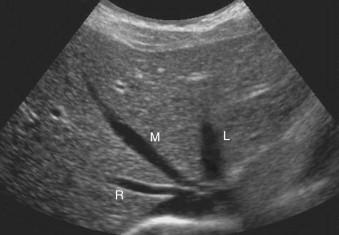
Refraction refers to a change in the direction of the sound and occurs when sound encounters an interface between two tissues that transmit sound at different speeds. Because the sound frequency remains constant, the wavelength changes to accommodate the difference in the speed of sound in the two tissues. The result of this change in wavelength is a redirection of the sound pulse as it passes through the interface ( Fig. 1-2 ). Refraction is important because it is one of the causes of mislocalization of a structure on an ultrasound image. Refraction is discussed in more detail in the “Artifacts” section.
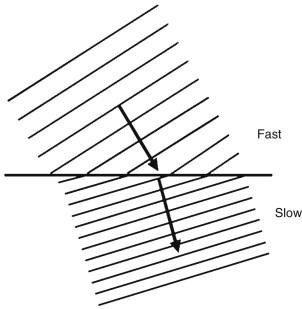
Absorption refers to the loss of sound energy secondary to its conversion to thermal energy. Absorption is greater in soft tissues than in fluid, and it is greater in bone than in soft tissues. Sound absorption is a major cause of acoustic shadowing. The combined effects of reflection, scattering, and absorption result in attenuation in the intensity of the sound pulse as it travels through matter. Attenuation limits the depth of imaging and is greater at higher transmit frequencies.
Ceramic crystals that deform and vibrate when they are electronically stimulated generate the sound pulses used for diagnostic sonography. Each pulse consists of a band of frequencies referred to as the bandwidth. The center frequency produced by a transducer is the resonant frequency of the crystal element and is dependent on the thickness of the crystal. Echoes that return to the transducer distort the crystal elements and generate an electric pulse that is processed into an image. High-amplitude echoes produce greater crystal deformation and generate a larger electronic voltage. They are then displayed on the image as brighter pixels than low-amplitude echoes. Because of this, standard two-dimensional (2D) gray-scale images are often referred to as B-mode (brightness mode) images.
The size and configuration of the transmitted sound pulse determine the resolution of the image. Resolution must be considered in 3D, as illustrated in Fig. 1-3 . Axial resolution refers to the ability to resolve objects within the imaging plane that are located at different depths along the direction of the sound pulse. This is dependent on the pulse length of the generated sound pulse, which in turn is dependent on the wavelength. Because wavelength is inversely proportional to the frequency, higher frequency probes produce shorter pulses and better axial resolution. As mentioned earlier, high-frequency sound does not penetrate deeply into tissues, so high-frequency probes are only useful for superficial structures. Lateral resolution refers to the ability to resolve objects within the imaging plane that are located side by side at the same depth from the transducer. This is dependent on the in-plane diameter of the pulse and can be varied within limits by adjusting the focal zone. Elevation resolution (azimuth resolution) refers to the ability to resolve objects that are at the same distance from the transducer but are located perpendicular to the plane of imaging. This is dependent on the out-of-plane diameter of the pulse, which is equivalent to the thickness of the tomographic slice. When crystal elements are arranged in a single row, slice thickness is determined by the shape of the crystal elements or the characteristics of fixed acoustic lenses and is not adjustable by the user. When crystal elements are arranged in multiple rows and columns, the slice thickness is variable and can be adjusted by the user. The resolution of different transducers can be tested using phantoms, as shown in Fig. 1-4 .
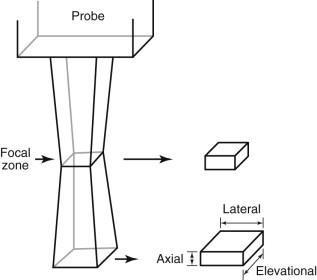
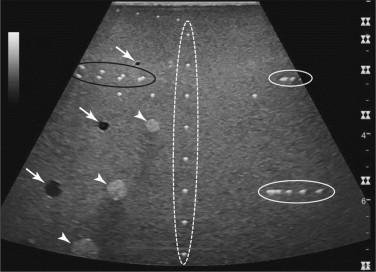
The early 2D units attached a B-mode transducer with a single large piezoelectric crystal element to an articulated arm that was capable of determining the exact location and orientation of the transducer in space. The distance of the reflector from the transducer was obtained by converting the time taken for the echo to return to the transducer based on the speed of sound in soft tissues (1540 m/s). This allowed the origin of the returning echoes to be localized in 2D. Then, by moving the transducer across the patient's body, a series of B-mode lines of information could be added together to produce a 2D image. With static B-mode imaging it was possible to view cross sections of large organs, such as the liver, or of the entire body on a single image, much like an axial CT scan ( Fig. 1-5 ). This was an advantage over modern real-time transducers, which have a much more limited field of view. The major disadvantage of static B-mode imaging was its lack of real-time capabilities. Because of this limitation, static articulated-arm B-mode devices have been replaced by real-time units.

Real-time images can be generated with a variety of transducers. The simplest design is the mechanical sector transducer, which uses a single large piezoelectric element to generate and receive the ultrasound pulses. Beam steering is accomplished by oscillating or rotating the crystal element itself, or by reflecting the sound pulse off an oscillating acoustic mirror. Beam focusing is done using different-shaped crystal elements or by attaching an acoustic lens to the transducer. Although the mechanical movement is fast enough to produce gray-scale images in real time, it is not fast enough to produce real-time color Doppler images. Other disadvantages of the mechanical sector transducer is the fixed focal zone and fixed transmit frequency. This forces the operator to switch to a completely different transducer to vary the focus distance and transmit frequency.
Because of their lack of flexibility, mechanical sector transducers have been replaced by multiple-element transducers, commonly called arrays. The array transducers contain groups of small piezoelectric crystal elements arranged in a sequential fashion. Transmitted sound pulses are created by the summation of multiple pulses from many different elements. By altering the timing and sequence of activation of the different elements, the transmitted pulse can be steered in different directions and focused at different depths ( Fig. 1-6 ). In fact, the multielement arrays can scan in real time while focusing at multiple levels.
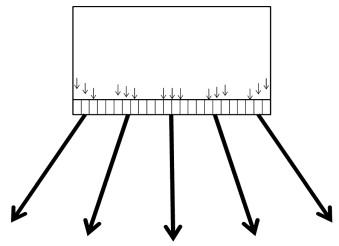
The image created by array transducers consists of multiple scan lines arranged side by side. The length of the scan line (image depth) multiplied by the speed of sound determines how much time it takes to generate each line. This time must be doubled because sound travels the length of the scan line and then back to the transducer. This travel time can then be multiplied by the total number of lines in the image to determine the time required to generate an entire frame of the real-time image. Because the speed of sound is essentially constant, the frame rate of the image can be adjusted by changing the depth of the image (length of the scan line), the width of the image (number of scan lines), or the line density (number of lines per degree or lines per cm).
With the phased-array transducer, every element in the array participates in the formation of each transmitted pulse. Because the sound beams are steered at varying angles from one side of the transducer to the other, a sector image format is produced. Compared with the other electronic array transducers (discussed in the following sections), the phased-array probe is smaller and therefore capable of scanning in areas where acoustic access is limited, such as between ribs. However, phased arrays have a small superficial field of view and poor near-field focusing capabilities. The focusing capabilities in the periphery of the image are also limited. Phased arrays are good for performance of deep Doppler but poor for superficial Doppler. They have been largely replaced by linear-array probes.
Unlike phased arrays in which all crystal elements are used to generate each transmitted sound pulse, linear arrays activate a limited group of adjacent elements to generate each pulse. Adjacent groups of elements are sequentially excited from one edge of the transducer to the other. If each sound pulse travels in the same direction (parallel) and is oriented perpendicular to the transducer surface, then the image is rectangular. It is also possible to steer the pulses so that the image is sector or trapezoidal in shape. The major advantages of linear-array transducers are high resolution in the near field and a larger superficial field of view. Focusing is uniform in the center and periphery of the image when there is no beam steering. Some loss of focusing and resolution occurs when the beam is steered into a sector or trapezoidal format. Linear arrays have largely replaced the traditional phased-array probes, although narrow linear arrays that steer the beam into a sector format closely simulate the traditional phased arrays and are often still referred to as phased-array or sector transducers. Images obtained with linear arrays always have a flat superficial surface and are designated on the image with the letter L followed by the transmit frequency. The various image formats of linear arrays are shown in Fig. 1-7 .
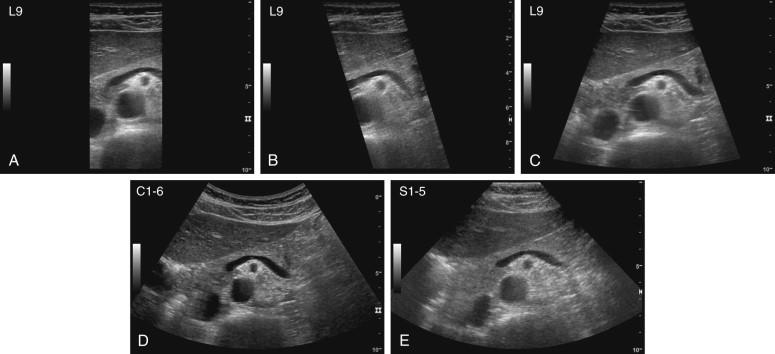
If the surface of a linear array is reformed into a curved convex shape, it is called a curved array, curvilinear array, or a convex array. Curved arrays can be formed in different sizes and shapes. Probes with a short radius of curvature can be used for endoluminal scanning and probes with a larger radius of curvatures can be used for general abdomen and obstetrical scanning. Images obtained with curved arrays always have a curved superficial surface and are designated on the image with the letter C followed by the transmit frequency (see Fig. 1-7 ).
In addition to transmit frequency, the size of linear and curvilinear probes also determines where they can be used. For example, large probes are acceptable for abdominal and obstetrical applications, but would not be feasible for scanning a finger.
Standard array transducers can produce variable focusing in the plane of imaging but cannot focus the beam perpendicular to the plane of imaging (i.e., the elevational plane). In other words, the slice thickness is fixed and cannot be adjusted. One solution to variable focusing in the elevation plane is the 2D array. These probes have crystal elements that are arranged in columns as well as rows ( Fig. 1-8 ). The 2D arrays are sometimes referred to as matrix arrays. They allow for variable slice thickness while maintaining the other advantages of electronically controlled arrays, such as color Doppler. They also allow for simultaneous scanning in more than one plane as well as real-time 3D imaging.
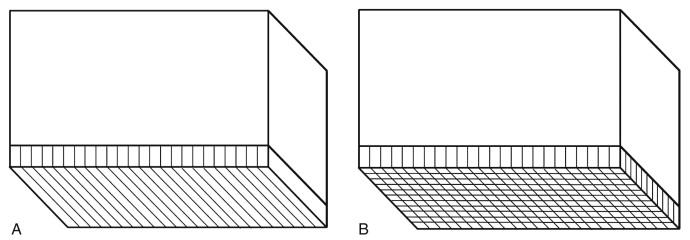
Small transducers that can be placed within various body lumens were developed in the 1980s and are now very common. Because these transducers can be positioned close to the organ of interest, higher frequencies can be used and higher resolution images obtained. In addition, the ability to image organs without having to transmit the sound beam through the abdominal wall helps to minimize the image-degrading properties of adipose tissue and the shadowing produced by bowel gas. The overall result is that the images are of much higher quality than those obtained with a standard transabdominal approach. The disadvantage is the limited imaging depth. Endovaginal and endorectal transducers are used most commonly ( Fig. 1-9 ). Very small transducers have been added to flexible endoscopes and bronchoscopes to scan and guide biopsies in both the gastrointestinal tract and thorax. Intravascular probes that fit on the end of catheters are also widely used in vascular applications.

In conventional scanning, the sound frequency of the echoes used to create the image is the same frequency as the transmitted sound pulses. Conventional sound pulses and their returning echoes progressively decrease in intensity as they travel through the body. Harmonic frequencies are higher integer multiples of the fundamental transmitted frequency. They are produced as the sound wave travels through tissues and progressively increase in intensity before eventually decreasing because of attenuation. With harmonic imaging, a filter is used to remove the fundamental echoes so that only the high-frequency harmonic signal is processed to produce an image. Although many harmonic frequencies are generated with propagation of the initial pulse, generally only the second harmonic, which is two times the transmitted frequency, is used.
Harmonic signals are narrower than the transmitted beam and have fewer side lobes (side lobes are discussed in more detail in the “Artifacts” section). The reduced width improves lateral resolution and the reduction in side lobes improves the signal-to-noise ratio. Furthermore, harmonic signals are produced after the beam enters the tissues of the body so that the degrading effect of body-wall fat is minimized ( Fig. 1-10 ). For this reason, harmonic imaging is theoretically even more valuable in obese patients.
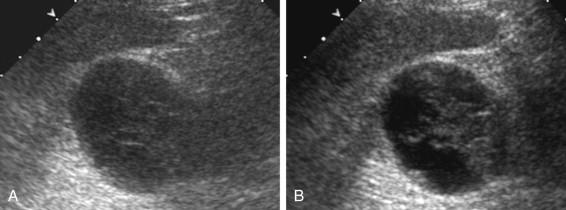
Real-time compounding refers to a technique in which individual image frames are created from sound steered at different angles and then averaged together to create a single displayed frame ( Fig. 1-11A and B ). By averaging signals originating from the different sound angles, high-level reflectors are accentuated and weak reflectors and noise are deemphasized. The net result is an improvement in signal-to-noise ratio and tissue contrast (see Fig. 1-11C and D ). Because of the frame averaging, it takes longer to generate each displayed frame, and therefore the response to movement (either transducer motion or internal motion such as fetal heart motion) is diminished and sluggish. Demonstration of shadowing is also reduced with spatial compounding.
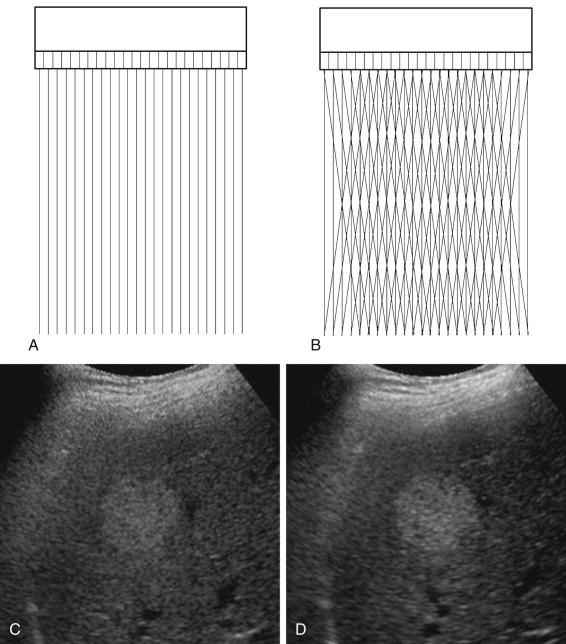
One disadvantage of real-time ultrasound is its limited field of view. This is especially true with high-resolution linear-array transducers when displayed in a rectangular image format. Thus spatial relationships and sizes often must be mentally synthesized from multiple real-time images that display only portions of the relevant anatomy. In addition, it is often difficult to display pertinent findings and relevant anatomy to someone who was not involved with the real-time scanning.
To overcome this limitation, image-registration–based position-sensing techniques allow for generation of panoramic images in real time with no loss in resolution and without an external position sensor. The technique uses an echo-tracking–based process for estimating probe motion that is applicable to all conventional real-time transducers ( Fig. 1-12 ).
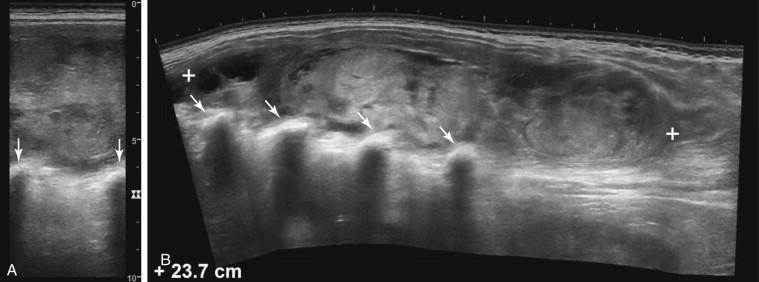
The m-mode is designed to document and analyze tissue motion. Using the 2D image as a guide, a particular scan line is selected to correspond to the moving structure of interest. The reflections from this scan line are then displayed in a graphic form, with motion on the vertical axis and time on the horizontal axis ( Fig. 1-13 ). This mode is particularly important in studying cardiac valve and wall motion and in documenting fetal heart rate and activity.

3D sonography has undergone continued refinement for many years. Data for 3D sonography are acquired as a stack of parallel cross sections with the use of a 2D scanner or as a volume with the use of a mechanically or an electronically driven array probe. The resultant 3D images can be displayed with a variety of formats, including multiplanar reformatting ( Fig. 1-14A ), surface rendering (see Fig. 1-14B ), volume rendering, and virtual endoscopy. 3D imaging is also possible in the color Doppler mode (see Fig. 1-14C ). Clinical applications are expanding, but the biggest impact is currently in the evaluation of gynecologic and fetal anatomy.

Real-time ultrasound images can be fused with other cross-sectional images by downloading volume sets into the ultrasound computer and linking anatomic landmarks between the two modalities. Using an electromagnetic transmitter positioned near the scanning area, a sensor attached to the ultrasound probe allows for real-time determination of the position and orientation of the probe. After linking structures seen on both modalities, the downloaded image volume from the prior CT, MRI, or positron emission tomography scan can then be reformatted to match the ultrasound image. The two sets of analogous images can be displayed side by side and viewed simultaneously, or they can be fused together ( e-Fig. 1-1 ![]() ). The benefits of fusion imaging are the ability to localize isoechoic lesions that are not visible with sonography, the ability to localize lesions obscured by overlying structures such as bones or bowel, and the ability to identify a particular lesion of interest when multiple lesions are present.
). The benefits of fusion imaging are the ability to localize isoechoic lesions that are not visible with sonography, the ability to localize lesions obscured by overlying structures such as bones or bowel, and the ability to identify a particular lesion of interest when multiple lesions are present.
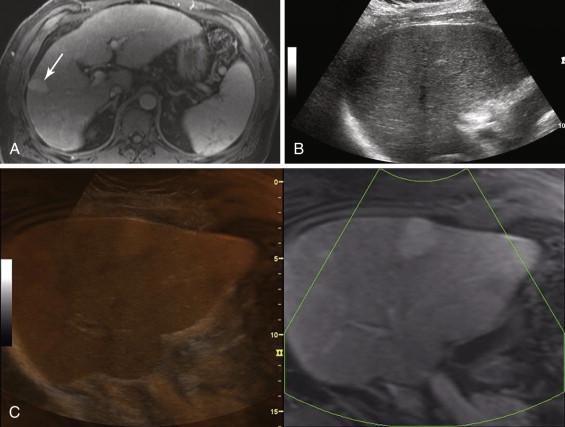
Focal masses and diffuse parenchymal diseases often differ from normal structures in their inherent stiffness. These differences can be exploited diagnostically using elastography. Applied external pressure produces variable compression of normal tissues, abnormal tissues, and focal lesions. Softer tissues and lesions have the greatest compression, whereas harder tissues and lesions have less compression. The property of compressibility can be tracked and displayed as a function of tissue displacement from the compressing device. In general, lesions with greater stiffness have a higher likelihood of being malignant. Most current elastography devices display tissue stiffness on a color scale and the elastogram is matched in real time with a dual-standard gray-scale image ( Fig. 1-15 ).
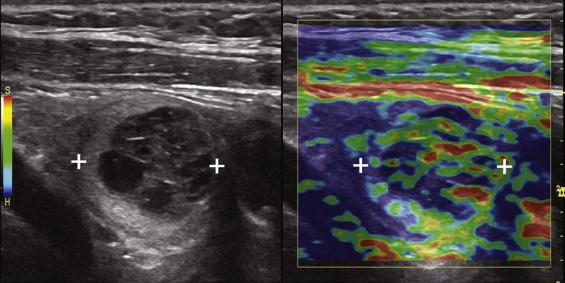
The transducer used should be matched to the application. Superficial structures such as the thyroid, scrotum, and musculoskeletal system should be scanned with high-frequency probes (with transmit frequencies typically varying from 7 to 15 MHz) to allow for the best possible resolution. This also applies to endoluminal applications because the structures of interest are very close to the probe. Because of limited penetration, high-frequency probes cannot be used for deep structures, and lower frequencies ranging from 2 to 5 MHz are typically used for abdominal, pelvic, and obstetrical scans. With most modern broad bandwidth probes it is possible to select different frequencies on the same probe. The probe used is often indicated on the image, with the letters L and C indicating linear and curved, respectively. The numbers following these letters indicate the frequency or range of frequencies of the probe. Other numbers associated with probe designation may indicate the size of the probe (for linear arrays) or the radius of curvature (for curved arrays).
Become a Clinical Tree membership for Full access and enjoy Unlimited articles
If you are a member. Log in here